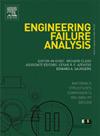基于蠕变-疲劳相互作用损伤模型的航空发动机涡轮叶片寿命预测
IF 5.7
2区 工程技术
Q1 ENGINEERING, MECHANICAL
引用次数: 0
摘要
针对航空发动机涡轮叶片蠕变-疲劳交互作用(CFI)寿命预测的挑战,提出了一种新的蠕变-疲劳交互作用损伤(CFID)模型。该模型同时考虑了不同的损伤作用系数和相互作用指标,建立了蠕变损伤(CD)、疲劳损伤(FD)和疲劳损伤(CFID)权重变化的定量关系。一个系统的方法,然后开发构建一个CFI寿命预测模型,结合应力调整系数ζ,这说明材料到结构的行为。然后,对应力-应变-温度场进行数值模拟,探索表征CFI载荷谱的等效方法。随后,对DZ125光滑试件和实际叶身特征进行CFI实验。实验结果表明,所提出的CFI寿命预测模型具有较高的精度,误差范围仅为3.21%。该研究为准确评估高温条件下材料和结构部件的寿命提供了一种强大的建模策略,为工程应用提供了重要的实用价值,并为航空发动机关键高温部件的抗损伤设计提供了理论基础。本文章由计算机程序翻译,如有差异,请以英文原文为准。
Aircraft engine turbine blade lifespan prediction based on a novel creep-fatigue interaction damage model
To address the challenges associated with predicting the creep-fatigue interaction (CFI) lifespan of turbine blades in aircraft engines, a novel creep-fatigue interaction damage (CFID) model is proposed. The model simultaneously incorporates different damage action coefficients and interaction indices, establishing a quantitative relationship for the varying weights of creep damage (CD), fatigue damage (FD), and CFID. A systematic methodology is then developed for constructing a CFI lifespan prediction model by incorporating the stress adjustment coefficient ζ, which accounts for material-to-structural behavior. Then, numerical simulations of the stress–strain-temperature fields were conducted to explore an equivalent approach for characterizing the CFI load spectra. Subsequently, CFI experiments were carried out on smooth DZ125 specimens as well as actual blade body features. The experimental results demonstrate that the proposed CFI lifespan prediction model achieves a high level of accuracy, with an error margin of only 3.21%. This study presents a robust modeling strategy for accurately evaluating the lifespan of materials and structural components under high-temperature conditions, offering significant practical value for engineering applications and a theoretical foundation for damage-resistant design of critical high-temperature components in aircraft engines.
求助全文
通过发布文献求助,成功后即可免费获取论文全文。
去求助
来源期刊

Engineering Failure Analysis
工程技术-材料科学:表征与测试
CiteScore
7.70
自引率
20.00%
发文量
956
审稿时长
47 days
期刊介绍:
Engineering Failure Analysis publishes research papers describing the analysis of engineering failures and related studies.
Papers relating to the structure, properties and behaviour of engineering materials are encouraged, particularly those which also involve the detailed application of materials parameters to problems in engineering structures, components and design. In addition to the area of materials engineering, the interacting fields of mechanical, manufacturing, aeronautical, civil, chemical, corrosion and design engineering are considered relevant. Activity should be directed at analysing engineering failures and carrying out research to help reduce the incidences of failures and to extend the operating horizons of engineering materials.
Emphasis is placed on the mechanical properties of materials and their behaviour when influenced by structure, process and environment. Metallic, polymeric, ceramic and natural materials are all included and the application of these materials to real engineering situations should be emphasised. The use of a case-study based approach is also encouraged.
Engineering Failure Analysis provides essential reference material and critical feedback into the design process thereby contributing to the prevention of engineering failures in the future. All submissions will be subject to peer review from leading experts in the field.
 求助内容:
求助内容: 应助结果提醒方式:
应助结果提醒方式:


